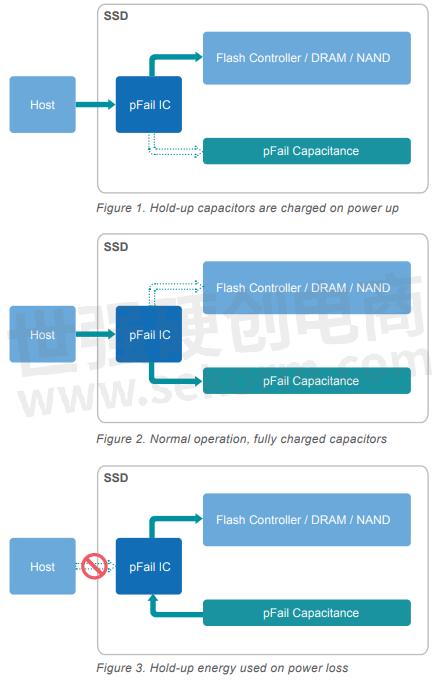SafeDATA™, SMART Modular‘s Trademarked Proprietary Power Loss Data Protection Technology

SafeDATA™, SMART Modular’s trademarked proprietary power loss data protection technology, is offered in SMART’s high-performance, solid-state drive (SSD) products to safeguard the integrity, functionality and data of the SSD in a sudden power loss event.
The concept of adding mitigation against power loss, often referred to as Power Failure Protection (pFail) or Power Loss Protection (PLP), has been a cornerstone in SSD design that makes SSDs a superior storage solution in reliability compared to a traditional hard disk drive (HDD) in critical applications. In high performance SSD architectures, user data and metadata critical to the operation of the SSD are often cached in volatile memory in the SSD controller internal SRAM and external DRAM components. Data caching allows faster read and write access by decoupling data transactions from the slower access and higher latency of the Flash media. To prevent the potential loss of “in-flight” user data in cache and critical metadata that can lead to the SSD becoming non-functional, SSD manufacturers have implemented various power loss protection schemes in their SSD designs.
Unlike the typical pFail or PLP implementation in many SSD products that offers rudimentary protection of user data, or simply safeguard the SSD from “bricking” after a sudden power loss, SafeDATA is a comprehensive suite of hardware and software (controller firmware) implementations that provides the highest level of protection beyond the basics. This includes the continuous monitoring of the integrity of the power loss protection electronics, intelligent power loss detection, data cache flush algorithms, and high reliability capacitors to provide hold-up power with redundancy to ensure long service for the lifetime of the SSD.
Why Power Loss Data Protection Technology Is Needed?
In order to improve SSD performance, user data are first written to a fast, low latency DRAM cache buffer instead of being
written directly to the slower NAND Flash memory. The SSD responds to the host with a write completion status when the
data are in the cache buffer. While writing to DRAM cache is much faster than writing to Flash memory, the cached data
remain “in-flight” until they are re-written to Flash memory in the background. The “in-flight” data can be lost permanently
when power unexpectedly cuts off. Also, metadata critical to the operation of the SSD, such as mapping table, event
logs and system tables are placed in cache memory during operation to ensure fast accessibility and updating. They can
be lost or damaged in a power loss event. A properly designed power loss data protection implementation can prevent
“in-flight” data and critical metadata from being lost.
How Does SafeDATA Work?
The main task of SafeDATA technology in SMART Modular’s SSD products is to provide a dynamic hardware control method and intelligent controller firmware algorithm to flush all data at risk from volatile memory to Flash media, preventing data loss during a sudden power loss event. The data at risk during an unexpected power loss are the metadata required by the controller for the operational integrity of the SSD and the user data in volatile cache. In high performance SSDs, data are written to a fast, low latency DRAM cache for high write performance compared to being written directly to the NAND Flash memory. The SSD controller then re-organizes and moves the data “in-flight” from the cache buffer to the Flash memory where the data “at rest” can safely reside from an unexpected power loss.
A SSD with SafeDATA is designed to include a pFail IC (integrated circuit) component and an array of high-value capacitors on the PCB (printed circuit board) to provide hold-up power to flush data from volatile cache to NAND Flash memory when power is lost. On power up, the pFail IC fully charges the holdup capacitors before drive initialization occurs. See Figure 1.
Once the hold-up capacitors are fully
charged, the pFail IC enables the power
to the SSD controller and other primary
components. See Figure 2. During normal
operations, the capacitors store energy
and do not affect the routine storage
activity of the SSD.
In an unexpected power loss, the pFail
circuits senses the voltage drop on the
input power signals and tells the SSD
controller, via a GPIO pin, to trigger the
SafeDATA algorithm to write the “in-flight”
data and critical metadata in cache to
the Flash memory with the cache flush
status monitored via another GPIO pin.
The capacitors provide power internally
to the SSD, long enough to complete the
data process. SafeDATA ensures all data
written by the host to the SSD in cache
buffer are hardened during a sudden
power loss event. See Figure 3.

Advantages of SafeDATA over Typical pFail/PLP Implementations
Hold-up power design
SMART Modular utilizes the highest quality Tantalum-polymer (Ta-poly) capacitors for hold-up power in SSDs with SafeDATA. Ta-poly capacitors provide high capacitance in a small form factor with low degradation and high reliability over wide operating temperature ranges. These exceptional properties of Ta-poly capacitors ensure reliable power loss data protection over the extended SSD product’s lifetime of service.
Robust power circuit design enables safe and efficient charging of hold-up capacitors with effective in-rush current control. The health of the hold-up capacitors is checked at SSD power-on and monitored periodically during operation. Any failure detected is reported in a vendor specific S.M.A.R.T. (Self-Monitoring, Analysis and Reporting Technology) attribute which alerts the host system of the potential risk of the hold-up power circuit not able to supply the power necessary to move the cached data to Flash memory in power loss event.
Power loss detection and cache flush algorithm
Proprietary power loss detection circuit design detects power loss events and is capable of distinguishing false positives caused by power line bounces. When power loss is detected, the SSD controller executes the SafeDATA firmware algorithm to terminate on-going operations and prioritize the flushing of data from cache memory to Flash within a tight timing window. The controller firmware incorporates robust error handling for corner cases such as the algorithm being mistakenly triggered by power supply instabilities.
What Happens If SafeDATA Fails?
The controller firmware has the capability to rebuild the mapping table and retrieve saved copies of the system tables and event logs in the event that the flushing of cached data to Flash memory fails to complete. Some user data “inflight” and metadata may be lost but the SSD shall remain operational and data that are stored in Flash memory can be accessed without corruption.
A failure to completely flush cached data to Flash memory from the last power event is reported in the S.M.A.R.T. attribute on the next power on. The host can use this indicator to verify expected data or react accordingly.
Who Needs SafeDATA?
Almost all data are considered valuable, but some data are considered more critical, such as medical data, military data and financial data. Data that are corrupt or lost due to an unexpected power loss could have serious consequences in these applications, thus, the need for SMART’s SafeDATA protection technology.
SMART Modular SSD Products with SafeDATA SMART
Modular offers SafeDATA in both the SATA III and PCIe NVMe SSD form factors, including M.2 2280 and 2.5” SATA, M.2 2280/22110 and U.2 PCIe NVMe. SafeDATA is standard on enterprise-class SSD product in EDSFF E1.S and U.2 PCIe NVMe form factors.

Why Use SMART Modular SafeDATA SSDs?
SMART Modular realizes the importance of protecting critical data in SSDs during unexpected power loss events. SafeDATA is a proven, robust, power loss data protection technology for SSDs deployed in many mission critical applications. With SafeDATA implemented on the SSD, data integrity is significantly improved. Continuous monitoring of the host power as well as the health of the hold-up capacitors ensures the SMART Modular SSD with SafeDATA is always ready for action.
- +1 Like
- Add to Favorites
Recommend
- Embedded Multi-Media Cards (eMMC) vs Solid-State Drives (SSD)
- Littelfuse Launches Industrial Solid-State Relays with Market Leading Reliability and Efficiency
- Photo MOSFET Solid-state Relay Compatible with CMOS
- A Comprehensive Introduction to NVMe Solid State Drive Form Factors
- Photo MOSFET Solid-state Relay Features High Current Rating of 800mA
- II-VI Introduces Ceramic YAG Optical Materials for Solid-State Lasers in Automotive LiDAR
- Photo MOSFET Solid-state Relay with 40Ω Low On-Resistance
- Photo MOSFET Solid-state Relay with Very Low On-Resistance of 0.5Ω
This document is provided by Sekorm Platform for VIP exclusive service. The copyright is owned by Sekorm. Without authorization, any medias, websites or individual are not allowed to reprint. When authorizing the reprint, the link of www.sekorm.com must be indicated.






























































































































































































































































































































































































































































































































































































































































































































































































































































































